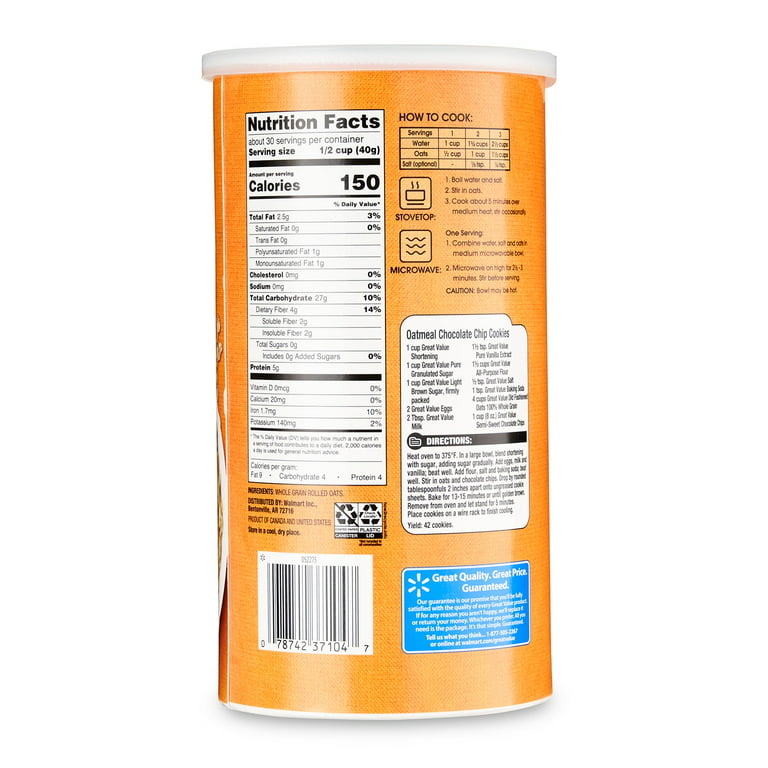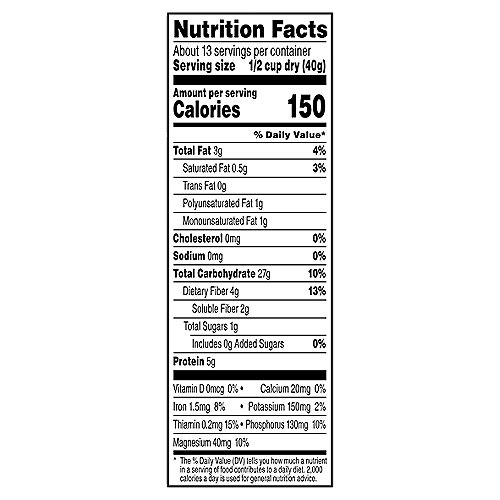Nutrition Facts Old Fashioned Oats, 12.5g protein, 6.25g fat, and 70g carbohydrates per serving. The nutritional value provides a healthy source of energy with high protein content.
Old Fashioned Oats, a versatile and nutritious breakfast choice, offer 375 kcal of energy, 12. 5g of protein, 6. 25g of fat, and 70g of carbohydrates per serving. Rich in fibre and essential nutrients, old-fashioned oats make for a wholesome and filling meal.
Whether used in oatmeal, smoothies, or baking recipes, oats are a great addition to a balanced diet. With their numerous health benefits and versatility, incorporating old-fashioned oats into your daily routine can support overall well-being and provide a satisfying and nutritious start to your day.

Credit: www.walmart.com
History Of Old Fashioned Oats
Old-fashioned oats, also known as rolled oats, have a rich history that spans centuries. Let’s delve into the origins and evolution of this versatile and nutritious grain.
Origins Of Oats
Ancient civilizations have cultivated oats for their nutritional benefits. Originating in Europe and Asia, oats were a staple food due to their high protein and fibre content.
Evolution Of Old Fashioned Oats
Old-fashioned oats evolved from traditional oat processing methods to meet modern consumption needs. The oats are steamed, rolled, and flattened to create the familiar texture we enjoy today.
Nutritional Content
Old-fashioned oats offer a rich nutritional profile, with 375 kcal of energy, 12. 5g of protein, 6. 25g of fat, and 70g of carbohydrates per serving. They are a great source of fibre and essential nutrients, making them a healthy option for breakfast or cooking.
Calories And Macronutrients
Old-fashioned oats are nutritious, providing 375 kcal, 12.5g protein, 6.25g fat, and 70g carbohydrates per serving.
Fiber And Micronutrients
In addition to macronutrients, old-fashioned oats are rich in fibre and micronutrients essential for overall health.
Essential micronutrients found in old-fashioned oats include:
- Iron: Supports oxygen transport in the body
- Magnesium: Important for muscle function and bone health
- Zinc: Supports immune system function
With 4g of fibre per serving, old-fashioned oats are an excellent source of dietary fibre.
Eating old-fashioned oats can help you reach your daily fibre goals and support digestive health.
Health Benefits
Old-fashioned oats offer many health benefits that make them valuable to a balanced diet.
Heart Health
Eating old-fashioned oats can contribute to heart health due to their high soluble fibre content. The beta-glucan in oats helps lower cholesterol levels, reducing the risk of heart disease.
Digestive Health
With a significant amount of fibre, old-fashioned oats promote digestive health by preventing constipation and supporting healthy digestion. The fibre content also aids in maintaining a healthy gut microbiome.
Weight Management
Old-fashioned oats are renowned for their ability to aid in weight management. They provide a feeling of fullness, helping to control appetite and manage weight. Additionally, being a low-calorie, nutrient-dense food, they support sustainable weight loss and maintenance.
Cooking And Consumption
When preparing old-fashioned oats, there are a few simple steps you can follow to ensure the perfect consistency and taste. First, measure out the desired amount of oats. A typical serving size is ½ cup, but you can adjust it according to your preference and nutritional needs.
Preparing Old Fashioned Oats
- In a saucepan, add one cup of water for every ½ cup of oats. You can use milk instead of water for extra creaminess.
- Bring the liquid to a boil over medium heat.
- Add the oats to the boiling liquid, reduce the heat to low, and let it simmer for about five minutes.
- Stir occasionally to prevent the oats from sticking to the bottom of the saucepan.
- After five minutes, remove the saucepan from the heat and let the oats rest for a minute or two.
- You can add your favourite toppings, such as fruits, nuts, or honey, to enhance the flavour and nutritional value.
Now that you have prepared your old-fashioned oats, let’s explore different ways to try them.
Variety In Consumption
Old-fashioned oats offer versatility in terms of consumption. Here are a few ideas to add some excitement to your oatmeal routine:
- Mix some cinnamon and sliced banana for a comforting and classic flavour combination.
- Create a decadent treat by adding a spoonful of chocolate hazelnut spread and some chopped hazelnuts.
- For a refreshing twist, top your oats with a handful of mixed berries and a drizzle of maple syrup.
- Add some sautéed veggies like spinach, mushrooms, and bell peppers to your cooked oats if you prefer savoury options.
Remember, the possibilities are endless, so feel free to experiment with different flavors and toppings to find what best suits your taste buds.
Comparison To Instant Oats
When choosing the best oats for your breakfast, comparing the nutritional facts of old-fashioned oats with instant oats is essential. These two types of oats differ in nutrient variations, texture, and flavour, which may impact your health and overall eating experience. Let’s take a closer look at the differences between these two popular oat varieties.
Nutrient Variations
Old-fashioned oats and instant oats contain similar nutrient profiles, including essential vitamins and minerals. However, slight variations in processing and cooking methods can affect their overall nutritional value.
Old-fashioned oats are typically less processed than instant oats and retain more fibre, protein, and nutrients, such as iron and magnesium. On the other hand, instant oats undergo more extensive processing, which may lead to a slight reduction in their nutritional content.
Texture And Flavor Differences
When it comes to texture, old-fashioned oats are known for their heartier and chewier texture, providing a more satisfying mouthfeel compared to instant oats, which tend to be softer and finer. The flavour of old-fashioned oats is also deeper and nuttier than that of instant oats, which are often blander in taste.
If you prefer a more robust texture and flavor in your oatmeal, old-fashioned oats may be the better choice. However, if convenience is your top priority, instant oats can be a quick and easy option for a nutritious breakfast.

Credit: www.fairwaymarket.com
Buying And Storing
Discover the optimal way to purchase and store your nutrition-rich old-fashioned oats for ultimate freshness. For top-quality options, check for great deals at Target, Walmart, and Amazon. Enjoy the convenience and health benefits of incorporating old-fashioned oats into your diet.
Choosing Quality Oats
When it comes to buying old-fashioned oats, it’s essential to choose a high-quality option that meets your nutritional needs. Look for oats labelled as “old fashioned” or “rolled oats.” These oats are processed by flattening the whole oat groat with oversized rollers, which helps retain the oat’s natural texture and flavour. Avoid instant or quick oats, which are more processed and may have added sugars or artificial flavours. Additionally, opt for organic oats to ensure that they are free from pesticides and other harmful chemicals. Taking these steps will guarantee you’re getting the best quality oats to incorporate into your diet.
Proper Storage Methods
Properly storing your old-fashioned oats is essential to maintain their freshness and prevent them from spoiling. Here are a few storage tips to keep in mind: 1. Keep them in an airtight container: Transfer your oats to airtight containers, such as glass jars or plastic storage bins. This will protect them from moisture and pests, ensuring they stay fresh for longer. 2. Store in a cool, dry place: Oats are best stored in a cool and dry location, away from direct sunlight. Excessive heat and moisture can cause them to spoil more quickly. 3. Avoid storing in the refrigerator: While some may recommend refrigerating oats to extend their shelf life, it can lead to moisture buildup and affect their texture. Stick to storing them in a cool pantry instead. 4. Check for any signs of spoilage: Before using your oats, always check for any spoilage, such as off smells or unusual discolouration. If you notice any, discard them immediately to avoid consuming spoiled oats. Following these proper storage methods ensures that your old-fashioned oats remain fresh and ready to use whenever you need them. Remember to check the expiration date on the packaging and consume them within that timeframe for the best taste and quality.
Oats In Popular Culture
Oats have been a significant part of popular culture for centuries, appearing in various forms across different cultures and time periods. Let’s explore the historical significance and culinary uses of oats in popular culture.
Historical Significance
Oats have a rich historical significance, dating back to ancient civilizations, where they were revered for their nourishing properties.
Culinary Uses In Various Cultures
Oats have been embraced in diverse culinary traditions around the world. Here are some examples:
- Scottish Cuisine: Oats are a staple in Scottish dishes like oatcakes and porridge.
- American Cuisine: Old-fashioned oats are commonly used in classic American recipes such as oatmeal cookies and overnight oats.
- Indian Cuisine: In Indian cuisine, oats are often incorporated into dishes like oat dosa and oat upma for a nutritious twist.

Credit: www.walmart.com
Future Trends In Oats
As the demand for healthy and sustainable food options rises, the future trends in oats are constantly evolving to meet consumer needs. Let’s explore the emerging trends in oat products and their role in sustainable agriculture.
Innovation In Oat Products
The future of oat products is laden with innovation as food companies explore new ways to incorporate oats into various products. From oat-based milk to oat protein bars, the possibilities are endless.
Oats In Sustainable Agriculture
Oats play a crucial role in sustainable agriculture due to their ability to improve soil health and reduce carbon footprint. As a rotation crop, oats contribute to biodiversity and promote eco-friendly farming practices.
Frequently Asked Questions Nutrition Facts Old Fashioned Oats
What are the nutritional facts for old-fashioned oats?
Old-fashioned rolled oats contain 375 calories, 12—5 g protein, 6. 25g fat, and 70g carbohydrates per serving.
Are Old Fashioned Oats Healthier?
Old-fashioned oats are healthy and provide similar nutrition benefits to other oats. They are a good source of energy, protein, healthy fats, and carbohydrates.
What Is The Nutritional Value Of 1 2 Cup Old Fashioned Oats?
Old-fashioned oats contain 375 kcal energy, 12—5 g protein, 6. 25g fat, and 70g carbohydrates in 1/2 cup.
What Is The Nutritional Value Of An Old Fashioned?
Old-fashioned oats have approximately 375 kcal of energy, 12. 5g of protein, 6. 25g of fat, and 70g of carbohydrates per serving.
Conclusion
Old-fashioned oats offer a nutritious and versatile addition to your diet. With a balanced macronutrient profile and heart-healthy fibre, they are a cost-effective and widely available option for promoting overall well-being. Whether enjoyed as a warm breakfast cereal or incorporated into various recipes, these oats can contribute to a wholesome and satisfying diet.






